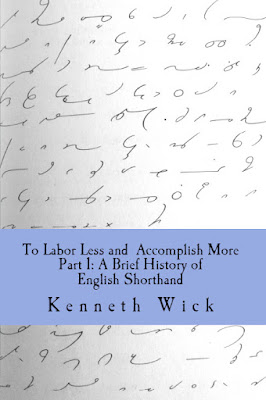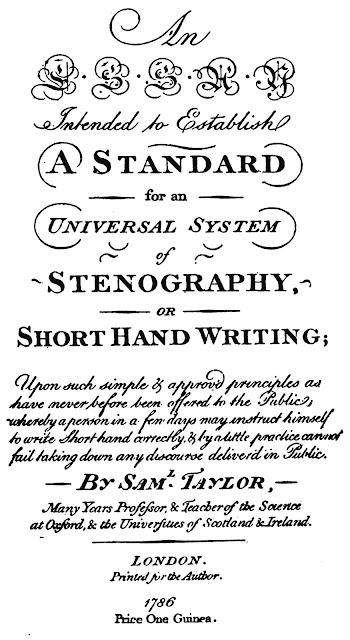 |
| Liverpool--Birthplace of Gregg Shorthand |
John, age twenty-six, arrived in Boston three weeks later greeted by Rutherford and an acquaintance, Louis Pfeiffer.
Rutherford told John about the poor economic climate: closed businesses and high unemployment causing City Hall soup lines. The time to begin a shorthand campaign was bad because most stenographers were unemployed.
Like Liverpool and Manchester, John launched his shorthand campaign with posters, advertisements in local newspapers, and visiting school teachers. John lacked the funds to publish the full shorthand textbook, so he printed a thirty-six page booklet titled "Gregg Shorthand Part One: The Elements" in October 1893.
Students trickled in, but it did not cover John and Rutherford's expenses. Miss Smith from Salem enrolled for twelve Saturday lessons. Initial skepticism evolved into enthusiasm as the lessons progressed. At the twelfth lesson, Miss Smith revealed she taught Phonography for the Salem Commercial School. The lessons converted her, and she became the first American teacher to switch shorthand systems. Salem Commercial School switched to Gregg in 1894 and became the first school to adopt Gregg Shorthand.
John’s situation grew bleak. John recounted their dreams and scarce resources during the Christmas of 1893:
“As Christmas approached business dwindled to the vanishing point—you all know how students drop off at that time of year. Now, Christmas is the day of days in the old country, and Rutherford and I determined that we were going to do the best we could to have one good Christmas. We summed up our joint capital and found that it amounted to one dollar and thirty cents. There was no possibility of getting any more anywhere.
Late on Christmas morning, we walked down to a hotel—walked to save carfare—and had our dinner, after carefully estimating the cost from the bill of fare. I should like to have a transcript of our conversation that dinner. We drew a picture of the United States covered with schools teaching Gregg Shorthand, we pledged each other's health, we stood up and shook hands over it, and vowed to continue with this thing in which we believed with all our hearts and souls until we had relieved the young people the world over from the drudgery of learning the old systems.
In figuring over the meal, we had reserved ten cents for the carfare home—we had not thought of any supper. But the waiter helped me with my overcoat—and away went the ten cents. We trudged home through the snow, and then Rutherford, who had a wife and family in England, played "Home, Sweet Home" and other cheerful airs on an old organ until we almost wept. Then we went to bed sufficiently sad. That was our first Christmas Day, and I shall never forget it.”
John and Rutherford agreed changes were needed. Rutherford went to New York but had little success. Month after month, John ended up supporting him with the meager Boston school profits. John organized a lecture tour in cities around Boston.
Victor Frazee, Providence High School Commercial Department member, attended a free lecture. Impressed by the presentation, Frazee recommended Gregg Shorthand instruction at the school. Providence High School is the first public school to adopt Gregg Shorthand. The teaching results from Providence High School convinced many other high schools to adopt Gregg Shorthand.
Pfeiffer’s father, a doctor, believed in John and loaned him the money to move to Chicago, to print a supply of textbooks, and to start a campaign. He also provided John with business contacts. John moved to Chicago in Spring 1894 and used the Liverpool business model to promote Gregg Shorthand.
John regularly traveled, visited teachers, and answered a mountain of mail. He invited Thomas Scully to be his secretary in late 1897. John established the Gregg Publishing Company, and in April 1898 the company published a new textbook and worked on a phrase book and a dictionary.
John collected motivational quotes. While exchanging quotes with a Chicago newspaper, John met and fell in love with Maida Wasson, a columnist. They shared common interests, and she supported him. They married in the summer of 1899.
Mr. Brown, the owner of seven prominent private schools in Illinois, tested Gregg Shorthand with success. Gregg Shorthand teaching spread to all Brown's schools and to over a hundred schools in Illinois, Iowa, Nebraska, and Missouri within six months.
Gregg Shorthand spread rapidly to many public and private schools after 1900. The Chicago office school for the next decade became the model and set the standard. Business expansion forced John to delegate responsibility, and he cautiously chose assistants he trusted and showed an immense enthusiasm.
John opened a New York office and moved there in 1907. He decided, for the first time in his life, to slow down. John visited and taught teachers during their summer recess, and vacationed during the winter.
Quest for the NSRA Speed Championship:
The Pitmanic writers pushed back. They sought to prove the best system through speed contests in the specialized and high-speed writing field of court reporting. The ultimate prize between the Pitmanic writers and the Gregg writers became the National Shorthand Reporters’ Association’s (NSRA) speed championship .
John studied courtroom vocabulary and devised outlines for common words and phrases. He published these in the 1907 The Gregg Reporter. John started a "Reporting Class" at the Chicago school in Fall 1908, and the championship quest began.
A turning point for Gregg writers came at the 5th International Shorthand Speed Contest in Washington, DC in 1910. Fred Gurtler, Charles Swem, and Salome Tarr won first, second, and third place in straight (non-legal) dictation. Swem had only eighteen months experience, and Tarr had less than two years experience.
At the 1911 NSRA speed championship, Charles Swem placed third and set a new accuracy record of 99.16% at 170 WPM. Governor Woodrow Wilson, impressed with Swem’s accuracy, invited nineteen year-old Swem to be his shorthand reporter during his 1912 presidency campaign. Swem worked as President Wilson’s personal shorthand writer for eight years from 1913 to 1921. He returned to NSRA speed championship training after Wilson’s Presidency.
Swem’s third place 1911 NSRA speed championship finish shocked Pitmanic writers who thought Gregg Shorthand was incapable of championship speed and accuracy. Nathan Bahrin, soon-to-be prominent Pitmanic writer, won the NSRA speed championship from 1911 to 1914. The NSRA suspended the speed championship from 1915 to 1918 for WWI.
Albert Schneider, a twenty year-old Gregg writer, won the 1921 NSRA speed championship held at Niagara Falls, Ontario. He defeated two former Pitmanic speed champions and set an accuracy record for literary dictation: 99.6% at 175 WPM.
Swem placed second at the 1922 NSRA speed championship behind Nathan Behrin. Leslie won the Amateur’s Championship. Martin Dupraw, a sixteen year-old high school student, qualified for the speed championship. Dupraw is the only high school student ever to qualify for the NSRA speed championship.
Swem placed first at the 1923 NSRA speed championship. Gregg writers dominated the speed championship winning first, second (Schneider), and third place (Dupraw). Swem again placed first at the 1924 NSRA speed championship defeating the top Pitmanic writer, Nathan Behrin. Dupraw placed third.
Dupraw placed first at the 1925 NSRA speed championship topping Swem (second) and Behrin (third). Dupraw placed first at the 1926 NSRA speed championship. Dupraw placed first at the 1927 NSRA speed championship, and the contest rules gave him permanent possession of the championship cup. The NSRA suspended the speed championship until 1952. The era of pen and paper champions had past. All entrants for the 1952 speed contest were machine writers.
Later Years:
For the 40th Anniversary of Gregg Shorthand, John and Maida traveled to Liverpool. In John’s address, he spoke highly of Maida who was sick and unable to the celebration dinner:
“I gladly and gratefully acknowledge that I owe much of whatever success I have had to her. She has been beside me—not behind me—for the last twenty-nine years. From the moment we married success seemed to come my way. I attribute that very largely to her wise counsel, her sympathy in good times and in bad, and her admonitions.”
Maida died in London on June 28, 1928. John returned to the USA with her body, and a funeral service was held in New York.
Recognition and marriage highlighted 1930. John received an honorary Doctorate in Commercial Science from Boston University in June 1930. He married Janet Kinley on December 4, 1930. Two children were born to their union: Kate in 1932 and John Junior in 1935. John immersed himself in various charities and in the National Arts Club where he served twice as president during the 1930’s.
John Robert Gregg died of a heart attack on February 23, 1947.
After John’s death, Janet Gregg became the President of The Gregg Publishing Company for a year. In 1948, The McGraw-Hill Publishing Company bought the Gregg Publishing Company, and it became a division under McGraw-Hill.














